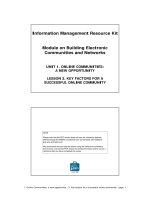Unit 06 Managing A Successful Computing Project.pdf
Bạn đang xem bản rút gọn của tài liệu. Xem và tải ngay bản đầy đủ của tài liệu tại đây (7.28 MB, 47 trang )
<span class="text_page_counter">Trang 1</span><div class="page_container" data-page="1">
<b>Higher Nationals in Computing </b>
<b>Unit 06: Managing a Successful Computing Project </b>
<b>ASSIGNMENT 1 </b>
Learner’s name: Nguyen Thi Hong Dan ID: GCS190090
Class: GCS0805_PPT Subject ID: 1625
<b>Assessor name: PHAN MINH TAM </b>
Assignment due: 3 1 / 0 1 / 2 0 2 1Assignment submitted: 3 1 / 0 1 / 2 0 2 1
</div><span class="text_page_counter">Trang 2</span><div class="page_container" data-page="2"><b> ASSIGNMENT 1 FRONT SHEET </b>
<b>Unit number and title Unit 06: Managing a Successful Computing Project </b>
</div><span class="text_page_counter">Trang 3</span><div class="page_container" data-page="3"><b>Summative Feedback: Resubmission Feedback: </b>
<b>Signature & Date: </b>
</div><span class="text_page_counter">Trang 4</span><div class="page_container" data-page="4">Submission Students are compulsory to submit the assignment in due date and in a way requested by the Tutors. The form of submission will be a soft copy in PDF posted on corresponding course of The Assignment must be your own work, and not copied by or from another student or from books etc. If you use ideas, quotes or data (such as diagrams) from books, journals or other sources, you must reference your sources, using the Harvard style. Make sure that you know how to reference properly, and that understand the guidelines on plagiarism. If you do not, you definitely get fail
<b>Assignment Brief and Guidance: </b>
Introduction to theme
Internet of Things
The Internet of Things (IoT) is the term which refers to the ever-growing network of physical objects with embedded sensors which can connect together via the internet allowing communication to occur between these objects and many other Internet-enabled devices and
</div><span class="text_page_counter">Trang 5</span><div class="page_container" data-page="5">systems.
The IoT is quickly becoming a necessary aspect of people’s daily lives. Physical items can now sense and collect data which can be controlled through digital and smart technology. The IoT extends internet connectivity beyond traditional devices like desktop and laptop computers, smartphones and tablets to a diverse range of devices that can utilise embedded technology such as security systems, thermostats, cars, electronic appliances, lights, medical equipment etc. These devices, often called "connected" or "smart" devices, can talk to other related devices (machine-to-machine (M2M) communication) and act on the information they get from one another.
Along with the many benefits there is also considerable concern over the IoT which must be overcome in order to harness the power of this free flow of information. This unit will enable students to explore the benefits of the IoT, the potential future developments, the most pressing challenges and how to overcome them.
<b>Tasks </b>
As a member of Research and Development department, you have been assigned a mini-project to find out do digital technologies improve life or distract from it and to explore the efficacy of products and features specifically designed to improve health and wellbeing.
You need to do primary research (both qualitative and quantitative research) and secondary research to find out that impact and conduct a report for your research. Even it’s a mini-project, you must apply project management (PM) techniques such as project charter with aims, objectives, cost etc. As for time management, you need to produce WBS and Gantt chart with reasonable tasks and time. A project logbook is required to provide evidence of the project development process and ongoing reflection for every week. This logbook will be needed later for your reflection and evaluation in Assignment 2. As part of QA (quality assurance) policy, in the report you also need to critically evaluate the PM process and appropriate research methodologies applied.
Your report must have an introduction stating the project aims and objectives. This must be followed by a copy of your project management plan. Your plan should show the milestones when you will review with your tutor your ongoing progress so far. You will submit your logbook which shows how you have carried out the project.
Guidance for Students
You should read this information before starting on your project. You should refer to these instructions as you complete work for this unit.
• Read the brief and think about what the project brief is asking.
</div><span class="text_page_counter">Trang 6</span><div class="page_container" data-page="6">• Research what the project brief is asking. How can you approach the problem, opportunity, hypothesis and requirements being posed?
• Apply a range of secondary research sources to plan/scope and support the project and its findings. Secondary research sources may include textbooks, journal articles, newspapers and magazine articles (not factual accounts).
• Develop your project plan based on the deliverables of the project, the constraints of the project and the assumptions made.
• Conduct your project according to your stated project plan and meet with your tutor to receive a off at each stage of the project process.
sign-• Primary research sources may include original first-hand accounts, legal and historical documents, results of experiments and market research data collection. Apply both qualitative and quantitative research methods to evaluate data collected from primary research.
• Keep notes of your progress throughout the project in your logbook. This is an important record of your work and must be used to record the development of your ideas and your progress through the project. The logbook should include:
• A record of what you did, when and what you were thinking.
• A record of where things went wrong and what you did to overcome any unexpected results. • You will be asked to reflect on the success of your project and your own performance in a personal performance review at the end of the project. This is a written reflection of around 500 words. • You must complete the project in order to complete your work for this unit.
Resources and useful links
Type of Resource Resource Titles Links
Web blog <sup>What risks do IoT security </sup><sub>issues pose to businesses? </sub>
security-business risk#:~:text=The%20biggest %20IoT%20threats%20to%20 businesses&text=One%20of %20the%20main%20IoT,if%2 0hacked%20by%20a%20cyb ercriminal.
Website
9 Main Security Challenges for the Future of the Internet Of Things (IoT)
09/05/9-main-security challenges-for-the-future-of the-internet-of-things-iot/Website <sup>The world’s best smart cities </sup><sub>don’t just adopt new </sub> <sup> </sup><sub>horizons/world-s-best-smart </sub>
</div><span class="text_page_counter">Trang 7</span><div class="page_container" data-page="7">technology: they make it work for people
cities-don-t-just-adopt-new technology-they-make-it work-people-4815Website <sup>Spotlight on the Internet of </sup><sub>Things </sub>
n/future
technologies/future-iotWebsite
Ericsson Technology Review: Spotlight on the Internet of Things -
n/reports-and papers/ericsson-technology review/articles/spotlight-on the-internet-of-things
Online Magazine
Erricsson Technology Review: Spotlight on the Internet of Things
a9407/assets/local/reports papers/ericsson-technology review/docs/2019/etr magazine-2019-special issue-iot.pdfYouTube Video
IoT and Machine Learning - Changing the Future | Dr. Dennis Ong | TEDxOhioStateUniversity
atch?v=mlE03Fj2T9s
YouTube Video
The coming privacy crisis on the Internet of Things | Alasdair Allan | TEDxExeterSalon
atch?v=yG4JL0ZRmi4YouTube Video <sup>Internet of Things: Are Smart </sup>Devices Helping or Harming?
| Rose Barker | TEDxSalem
atch?v=ipdTLJcIkWI
<b>Learning Outcomes and Assessment Criteria </b>
<b>LO1 Establish project aims, objectives and timeframes based on the chosen theme </b>
<b>LO1 & LO2 </b>
<b>D1. Critically evaluate the </b>
project management process and appropriate research methodologies applied.
<b>P1 Devise project aims and </b>
objectives for a chosen scenario.
<b>P2 Produce a project </b>
management plan that covers aspects of cost, scope, time, quality, communication, risk and resources.
<b>P3 Produce a work breakdown </b>
structure and a Gantt Chart to
<b>M1 Produce a comprehensive </b>
project management plan, milestone schedule and project schedule for monitoring and completing the aims and objectives
<b>of the project. </b>
</div><span class="text_page_counter">Trang 8</span><div class="page_container" data-page="8">provide timeframes and stages
<b>for completion. </b>
<b>LO2 Conduct small-scale research, information gathering and data collection to generate knowledge to support the project P4 Carry out small-scale </b>
research by applying qualitative and quantitative research methods appropriate for meeting project aims and objectives
<b>M2 Evaluate the accuracy and </b>
reliability of different research methods applied.
</div><span class="text_page_counter">Trang 9</span><div class="page_container" data-page="9"><b>Table of Contents </b>
<b>Unit 06: Managing a Successful Computing Project ASSIGNMENT 1 ...1 </b>
<b>P1 Devise project aims and objectives for a chosen scenario. ...1 </b>
<b>1. Introduction to Project Management (PM) ... 1 </b>
<b>1.1. Project Management Definition ... 1 </b>
<b>1.2. Software Project Management Definition ... 1 </b>
<b>2. The key stages of project management ... 2 </b>
<b>3. The advantages of using project management and why it is important ... 6 </b>
<b>4. Research project proposal ... 6 </b>
</div><span class="text_page_counter">Trang 10</span><div class="page_container" data-page="10"><b>3. Evaluation about interview and survey ... 28 </b>
<b>M1 Produce a comprehensive project management plan, milestone schedule and project schedule for monitoring and completing the aims and objectives of the project. ... 29 </b>
<b>1. Comprehensive project manager plan ... 29 </b>
<b>2. Milestone schedule ... 31 </b>
<b>M2 Evaluate the accuracy and reliability of different research methods applied. ... 32 </b>
<b>1. Different between research methods applied ... 32 </b>
<b>2. Evaluate ... 33 </b>
<b>D1. Critically evaluate the project management process and appropriate research methodologies applied. ... 34 </b>
<b>REFERENCES ... 36 </b>
</div><span class="text_page_counter">Trang 11</span><div class="page_container" data-page="11">P a g e | <b>1</b>
<b>ASSIGNMENT 1 ANSWERS </b>
<b>P1 Devise project aims and objectives for a chosen scenario. </b>
<b>1. Introduction to Project Management (PM) 1.1. Project Management Definition </b>
Project management is the process of leading the work of a team to achieve goals and meet success criteria at a specified time. The primary challenge of project management is to achieve all of the project goals within the given constraints. This information is usually described in project documentation, created at the beginning of the development process. The primary constraints are scope, time, budget. The secondary challenge is to optimize the allocation of necessary inputs and apply them to meet pre-defined objectives.
Project management was developed to save time/money by properly planning a project and considering all relevant factors which may affect its outcome.
Figure 1: Project management processes.
<b>1.2. Software Project Management Definition </b>
Software project management refers to the branch of project management dedicated to the planning, scheduling, resource allocation, execution, tracking and delivery of software and web projects.
Project management in software engineering is distinct from traditional project management in that software projects have a unique lifecycle process that requires multiple rounds of testing, updating, and customer feedback. Most IT-related projects are managed in the agile style, in order to keep up with the increasing pace of business and iterate based on customer
</div><span class="text_page_counter">Trang 12</span><div class="page_container" data-page="12">P a g e | <b>2</b>
and stakeholder feedback.
Figure 2: Software project management process.
<b>2. The key stages of project management </b>
Figure 3: The key stages of project management.
<b>2.1. Project Initiation </b>
Project initiation is the first phase of the project management life cycle and in this stage, companies decide if the project is needed and how beneficial it will be for them. The two metrics that are used to judge a proposed project and determine the expectations from it are the business case and feasibility study.
</div><span class="text_page_counter">Trang 13</span><div class="page_container" data-page="13">P a g e | <b>3</b>
Figure 4: Project initiation process.
Business Case Document – This document justifies the need for the project, and it includes an estimate of potential financial benefits.
Feasibility Study – This is an evaluation of the project’s goals, timeline and costs to determine if the project should be executed. It balances the requirements of the project with available resources to see if pursuing the project makes sense.
Teams abandon proposed projects that are labeled unprofitable and/or unfeasible. However, projects that pass these two tests can be assigned to a project team or designated project office.
<b>2.2. Project Planning </b>
A project plan, also known as the project management plan, is the document that describes how the project will be executed, monitored, and controlled, and closed. This outlines the objectives and scope of the project and serves as an official point of reference for the project team, larger company, and stakeholders.
</div><span class="text_page_counter">Trang 14</span><div class="page_container" data-page="14">P a g e | <b>4</b>
It’s created during the project planning phase and is a compilation of several other documents. It is more than just a schedule or a task list, though it does include those things. The project management plan is formally approved at the beginning of the project and then progressively updated throughout the course of the project.
<b>2.3. Project Execution </b>
The execution phase is usually the longest phase in the project life cycle; and the most demanding. Your team carries out all the planned activities during this stage, constructs the deliverables, and presents them to the project stakeholders.
This is the phase that is most commonly associated with project management. Execution is all about building deliverables that satisfy the customer. Team leaders make this happen by allocating resources and keeping team members focused on their assigned tasks. Execution relies heavily on the planning phase. The work and efforts of the team during the execution phase are derived from the project plan.
In project management, there might be hiccups along the way but if you catch them early on, it’s easy to course orrect. You’ll need to continuously track the project’s progress and ensure -cthat the milestones and deliverables stick to the project schedule. For this reason, the execution stage always happens in concurrence with the next phase project controlling and –monitoring.
Figure 5: Project Execution process.
</div><span class="text_page_counter">Trang 15</span><div class="page_container" data-page="15">P a g e | <b>5</b>
<b>2.4. Project Monitoring and Control </b>
Monitoring and control processes continually track, review, adjust and report on the project’s performance. It’s important to find out how a project’s performing and whether it’s on time, as well as implement approved changes. This ensures the project remains on track, on budget and on time.
Project control is a <project management function that involves comparing actual performance with planned performance and taking appropriate corrective action (or directing others to take this action) that will yield the desired outcome in the project when significant differences exist.=
Essentially, project controls are a series of tools that help keep a project on schedule. Combined with people skills and project experience, they deliver information that enables accurate decision making.
Figure 6: Monitoring & Control process.
</div><span class="text_page_counter">Trang 16</span><div class="page_container" data-page="16">P a g e | <b>6</b>
<b>2.5. Project Closure </b>
Teams close a project when they deliver the finished project to the customer, communicating completion to stakeholders and releasing resources to other projects. This vital step in the project lifecycle allows the team to evaluate and document the project and move on the next one, using previous project mistakes and successes to build stronger processes and more successful teams.
<b>3. The advantages of using project management and why it is important </b>
The main advantage of project management is that helps you to manage your projects effectively, enabling you to resolve problems more quickly. It takes time and money to manage a project, however following good practices can help you:
• Improve your chances of achieving the desired result
• Gain a fresh perspective on your project, and how it fits with your business strategy • Priorities your business’ resources and ensure their efficient use
• Set the scope, schedule and budget accurately from the start • Stay on schedule and keep costs and resources to budget • Improve productivity and quality of work
• Encourage consistent communications amongst staff, suppliers and clients • Satisfy the various needs of the project’s stakeholders
• Mitigate risks of a project failing • Increase customer satisfaction
• Gain a competitive advantage and boost your bottom line
Not having a process to manage your projects can result in lost time, wasted money, inconsistencies and poor performance. Find out more about the benefits of following a project management method.
<b>4. Research project proposal 4.1. Title </b>
Research to develop the automatic robotic vacuum cleaner controlled by smartphone.
</div><span class="text_page_counter">Trang 17</span><div class="page_container" data-page="17">P a g e | <b>7</b>
<b>4.2. Introduction </b>
A robotic vacuum cleaner is an autonomous robotic vacuum cleaner which has intelligent programming and a limited vacuum floor cleaning system. The original design included manual operation via remote control and a "self-drive" mode which allowed the machine to clean autonomously without human control. Some designs use spinning brushes to reach tight corners, and some include a number of cleaning features along with the vacuuming feature (mopping, UV sterilization, etc.).
There are many brands of the robotic vacuum cleaner on the market today. This robot's working mechanism is integrated with the application on user's phone. Users can easily use the robot to clean their house without having to waste time and effort to clean the traditional way.
- The robotic vacuum cleaners can solve all kinds of dirt that are difficult to clean, efficiently and completely automatically. And that is the most important objective of the robotic vacuum cleaner, completely solving the worry of cleaning the house.
- Robotic vacuum cleaners in the market are expensive and inefficient in terms of cleaning time and cleanness. The goal is to design an omnidirectional platform with infrared sensors, wireless sensors, bumpers, ultrasound, reshape, and four bristle brushes on every side to improve the cited cleaning performance problems.
<b>P2 Produce a project management plan that covers aspects of cost, scope, time, quality, communication, risk and resources. </b>
<b>1. Project scope </b>
</div><span class="text_page_counter">Trang 18</span><div class="page_container" data-page="18">P a g e | <b>8</b>
<b>PROJECT SCOPE</b>
<b>Project Goal: </b>Research to develop the automatic robotic vacuum cleaner controlled by smartphone aims to provide consumers with modern and automated living.
<b>Deliverables: </b>
• Application for everyone in or out of the country. • User manuals, support service 24/7. • Research document.
• Application document.
<b>Acceptance criteria: </b>
• Navigation system and programming
It is important to compare the navigation systems which must be simple, efficient, have a good obstacle managing, and have a precise vacuum of surfaces.
• The filter of the vacuum cleaning robot
There are plenty of different filter types which allow a more or less efficient cleaning of your floors: classical filters, anti-allergen filters to hold more dust particles or HEPA filter (High Efficiency Particles Arresting) defining devices able to filter in one time more than 99, 97% of particles.
• The noise level of the robot
This point is essential if you wish to make your robot work during the night but will be less essential if you are planning to make it work while you’re not at home. You need to see according
</div><span class="text_page_counter">Trang 19</span><div class="page_container" data-page="19"><b>2. Project time </b>
<b>PROJECT TIME</b>
Research to develop the automatic robotic vacuum cleaner controlled by smartphone.
January 12, 2021 March 11, 2021 58 days
<b>2. Planning/Design Phase </b> January 21, 2021 February 2,2021 12 days
<b>4. Monitor and Control Phase </b> February 10, 2021 February 22, 2021 12 days
<b>3. Project resources </b>
</div><span class="text_page_counter">Trang 20</span><div class="page_container" data-page="20">P a g e | <b>10</b>
<b>HUMAN RESOURCES</b>
1 Nguyen Thi Hong Dan Project manager 0942757177
3 Tran Dang My Ngan Interface Development 0707058412
<b>4. Project cost </b>
<b>HUMAN RESOURCES COST</b>
Nguyen Thi Hong Dan January 12, 2021 March 11, 2021 58 days $1740
Dang An Thanh January 12, 2021 March 11, 2021 58 days $1450
Tran Dang My Ngan January 21, 2021 March 11, 2021 45 days $1225
Tran Dai Phu February 10, 2021 March 11, 2021 18 days $580
<b>• Probability Values: Likely</b>, <b>Possible</b>, <b>Unlikely</b>
<b>• Severity Values</b>: <b>Serious, Moderate, Minor </b>
</div><span class="text_page_counter">Trang 21</span><div class="page_container" data-page="21">3
<b>Research process </b>
<b>P3 Produce a work breakdown structure and a Gantt Chart to provide timeframes and stages for completion. </b>
<b>1. Requirements analysis 1.1. Define requirement </b>
<b>• Project Idea </b>
Identify and design an autonomous robot that can assist people at home who are too busy for daily or weekly floor cleaning, for families with children. In particular for the elderly who live by themselves and do not have the strength or ability to clean.
<b>• Data Collection </b>
Customer information security surveyed about the need to use robotic vacuum cleaner. The project collects information from various sources, validated and verified. The goal is to seek out and fully comply with the law.
<b>• User requirement research </b>
</div><span class="text_page_counter">Trang 22</span><div class="page_container" data-page="22">P a g e | <b>12</b>
Meet all of user requirements about using robotic vacuum cleaner.
<b>• Evaluate and analyze </b>
Users will insert their information in the app and connect the app on their phone with their robotic vacuum cleaner. The system will track user and will evaluate, analyze the average time user use the application to control robotic vacuum cleaner in 1 day, 1 week or 1 month.
<b>• Report </b>
We will try to fix and upgrade the system also as application according to user feedback.
<b>1.2. Work Breakdown Structure (WBS)</b>
</div><span class="text_page_counter">Trang 23</span><div class="page_container" data-page="23">P a g e | <b>13</b>
Figure 7: Work breakdown structure (WBS) of my project.
</div>








